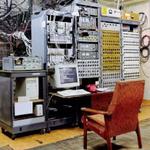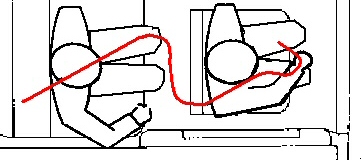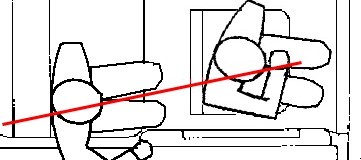JFK - Attentataufdeckung
07.06.2025 um 22:51Also, ich interpretier es als Griff zum Hals, zumal sich Jackie ja auch noch zu ihm rüber beugt. Und das noch vor dem Kopfschuss.Nemon schrieb:Ist das gemeint oder was anderes?
Also, ich interpretier es als Griff zum Hals, zumal sich Jackie ja auch noch zu ihm rüber beugt. Und das noch vor dem Kopfschuss.Nemon schrieb:Ist das gemeint oder was anderes?

Da kann er stundenlang begründen, es bleibt Unsinn.MoviesandArt schrieb:Der Schuss in den Hals kam von vorn, er begründet das auch.
Warum? Ich verlasse mich lieber auf die Aussagen von Experten, die vor Ort dabei gewesen sind, nicht auf einen Thread, in dem die meisten Quellangaben gar nicht mehr aufrufbar sind.Groucho schrieb:Da kann er stundenlang begründen, es bleibt Unsinn.
Alle Achtung, dann wundere ich mich, wieviele Experten, die das angeblich rauf - und runterwiderlegt haben, davon im OP Saal waren und Expertisen anfertigten.Groucho schrieb:Wurde hier im Thread auch schon rauf und runter widerlegt.
Wie wäre es mit Boswell und Hume?MoviesandArt schrieb:Alle Achtung, dann wundere ich mich, wieviele Experten, die das angeblich rauf - und runterwiderlegt haben, davon im OP Saal waren und Expertisen anfertigten.

Auch Experten, die vor Ort dabei waren, können sich irren.MoviesandArt schrieb:Ich verlasse mich lieber auf die Aussagen von Experten, die vor Ort dabei gewesen sind,
Also wenn jemand, der Verschwörungstheorien zum Kennedy-Attentat zum besten gibt, eine Person als "Experten" bezeichnet, bin ich geneigt zu sagen, dass diese Person vom Tuten und Blasen keine Ahnung hat. Aber natürlich begehe ich diesen Logikfehler nicht (das überlasse ich den Verschwörungstheoretikern), sondern ich prüfe diese Aussage nach. War Dr. Curtis wirklich ein "Experte"? Das lässt sich ganz leicht nachvollziehen, da er von der Warren Commission vernommen wurde und alle befragten nach ihrem Beruf und ihrer Ausbildung befragt wurden. Wie liegt die Sache nun bei Dr. Curtis?MoviesandArt schrieb:Warum? Ich verlasse mich lieber auf die Aussagen von Experten, die vor Ort dabei gewesen sind, nicht auf einen Thread, in dem die meisten Quellangaben gar nicht mehr aufrufbar sind.
Nun, bei Kennedy waren mit Sicherheit keine Experten, was Wundballistik angeht; das ist bekannt, da die Aussagen der Ärzte, die im ER anwesend waren bekannt und öffentlich verfügbar sind.MoviesandArt schrieb:Alle Achtung, dann wundere ich mich, wieviele Experten, die das angeblich rauf - und runterwiderlegt haben, davon im OP Saal waren und Expertisen anfertigten.

Und jetzt sehen wir uns das Transkript des Hearings an und prüfen, ob das stimmt, was du sagst. Da zu Dr. Curtis kein Originaldokument vorliegt, weil er vermutlich kein Statement eingereicht hat, siehe: https://oversight.house.gov/hearing/the-jfk-files-assessing-over-60-years-of-the-federal-governments-obstruction-obfuscation-and-deception/ ... nehmen wir das Roh-Transkript des obigen YouTube-Videos (in meinem Auftrag erstellt von NoteGPT):MoviesandArt schrieb:Gut, dann hier noch eine genauere Beschreibung von Dr. Curtis zum Zustand von Kennedy nach seiner Einlieferung, der Beschaffung der Wunden, welche tötlich waren und welche nicht und eine Beschreibung der Einschusswinkel. Nur weil jemand älter ist und er etwas schwerhörig ist, (sein Mikro war wohl kurz ausgeschaltet), ist das noch lange kein Grund, ihm nicht zu glauben, was er hinsichtlich seiner Untersuchungen damals festgestellt hat. Ginge es danach, hätte man die gesamte Warren Kommission, die fast nur aus laten Männern bestand, nicht einberufen sollen. Und er wiederholt und präzisiert das. Der Schuss in den Hals kam von vorn, er begründet das auch.
00:00Quelle: s. o.
recognize Mr. Crane for five minutes. Thank you, uh, Mr. Chairwoman. Thank you guys for coming today. I want to start with you, Dr. Curtis. Um, as a dental surgeon who was present in the hospital room the day President Kennedy was shot, you were able to observe his wounds and maybe some of his medical records. Is that correct? Can you not hear me, Dr. Curtis? So you you were there in in the emergency room the day that the president was brought in? Yes. How old were you, sir? How old was I? Yeah. 26.
00:40
26. And what did you observe um when they brought the president in? The president was already in the room before I arrived. and uh what I observed about him that he had probably already deceased. Since you were a dental surgeon, why did they bring you into the operation room? That's one thing Arlene Spectre asked me. Uh what is a dentist doing operating on the president? Then I had to qualify myself. the the training that I have would encompass those particular procedures and that's a simple procedure and and I
01:27
did it well and I just knew how to do it. There was nobody else there to do it and I did it because Dr. uh Carico asked me to do it. Can you tell us about the wounds that you observed on the president and how they differ from what came out in some of the reporting? The wounds on the president were to his throat and to his head and to his back. The the wound wound to his throat would have killed him. The wound to his head definitely would have killed him. The wound to his back would not have killed him.
02:06
Did the wounds to his throat and his head look like completely separate wounds? They were two separate wounds. The one, let me show it to you. The the blue wound was f was found was was sent from the railroad trestle all the way over to kill him right here. And that went to his throat. And the way that killed him is that it obslicted the the trachea and and he couldn't breathe. So he would have been dead before he reached the hospital just simply because of that wound. The other wound that he had to his head would have killed him
02:46
instantly because it removed about a third of his brain.
Nein, die Elm Street war im Gegensatz zur Houston Street relativ frei von Publikum. Weil der Routenverlauf erst einen Tag vorher in einer Zeitung veöffentlicht wurde. Bis dahin war er nur dem Secret Service und dem CIA bekannt. Dem Secret Service wurden übrigens nach dem aufgeckten Attentatsversuch Anfang November 15 Mitarbeiter entzogen worden. Da in anderen Threads Buchveröffentlichungen auch stattfinden, hier die Quelle: https://www.mail-order-kaiser.de/geschichte/ab-1949/secret-service-die-geheime-geschichte-der-agenten-die-den-us-praesidenten-schuetzen-sollen.htmlNemon schrieb:Der angeblich tödliche Einschuss in den Hals soll also von der Eisenbahnbrücke gekommen sein. Auf die der Konvoi zufuhr. In deren Richtung das gesamte Publikum blickte, als sie den Weg der Limousine verfolgten.
Und genau das ist das Problem hier in diesem Thread. Die Warren Kommission ist schon lange tot. Wie wir aus den neuen Akten wissen, wurde sie vom CIA massiv getäuscht. So wurde James Jesus Angleton gefragt, ob er was von einem Lee Harvey Oswald wusste. Antwort: Praktisch so gut wie nichts. Tja, nun ist bei den neuen Akten aber ein Dossier von 189 Seiten aufgetaucht, das über Angeltons Tisch gegangen sein muss, da es seine Unterschrift trägt. Also in meinen Augen sind 189 Seiten nicht nichts, sonder eine ganze Menge.Africanus schrieb:Hinweis: Alle Zitate habe ich der offiziellen Aufzeichnung seiner Aussage vor der Warren Commission entnommen, siehe
Alle Achtung, den ollen Specter hier nochmal reinzuschmuggeln mit seiner hirnrissigen magischen Kugel Theorie. Und es ist Standard, auch bei uns, in einem Todesfall oder bei schweren Verletzungen mit Einlieferung ins Krankenhaus alle verfügbaren Ärtze sämticher Fachrichtungen miteinzubeziehen. Das ist jetzt wirklich nicht Besonderes. Sagt DR. Curtis auch selbst in dem ersten verlinkten Video mit Curtis.Africanus schrieb:Mr. Specter: And what is your occupation or profession?
Dr. Curtis: Oral surgeon.
Naja, "relativ frei" heißt in dem Fall immer noch eine Menge Leute.MoviesandArt schrieb:Nein, die Elm Street war im Gegensatz zur Houston Street relativ frei von Publikum
Das macht aus Dr. Curtis noch lange keinen "Experten" für Schusswunden.MoviesandArt schrieb:Und es ist Standard, auch bei uns, in einem Todesfall oder bei schweren Verletzungen mit Einlieferung ins Krankenhaus alle verfügbaren Ärtze sämticher Fachrichtungen miteinzubeziehen. Das ist jetzt wirklich nicht Besonderes. Sagt DR. Curtis auch selbst in dem ersten verlinkten Video mit Curtis.

Das ist kein valides Argument gegen meine Aussage.MoviesandArt schrieb:Nein, die Elm Street war im Gegensatz zur Houston Street relativ frei von Publikum.
What? Wer ist der doppelte Curtis?MoviesandArt schrieb:Und es ist Standard, auch bei uns, in einem Todesfall oder bei schweren Verletzungen mit Einlieferung ins Krankenhaus alle verfügbaren Ärtze sämticher Fachrichtungen miteinzubeziehen. Das ist jetzt wirklich nicht Besonderes. Sagt DR. Curtis auch selbst in dem ersten verlinkten Video mit Curtis.
Also zitiere bitte, was er deiner Aussage zufolge sagt. Das stimmte zuletzt auch schon nicht.MoviesandArt schrieb:Sagt DR. Curtis auch selbst in dem ersten verlinkten Video mit Curtis.

Subject: Statement concerning resuscitative efforts for President John F. Kennedy
Upon receiving a stat alarm that this distinguished patient was being brought to the emergency room at Parkland Memorial Hospital, I dispatched Doctors A. H. Giesecke and Jackie H. Hunt with an anesthesia machine and resuscitative equipment to the major surgical emergency room area, and I ran down the stairs. On my arrival in the emergency operating room at approximately 1230 I found that Doctors Carrico and/or Delaney had begun resuscitative efforts by introducing an orotracheal tube, connecting it for controlled ventilation to a Bennett intermittent positive pressure breathing apparatus. Doctors Charles Baxter, Malcolm Perry, and Robert McClelland arrived at the same time and began a tracheostomy and started the insertion of a right chest tube, since there was also obvious tracheal and chest damage. Doctors Paul Peters and Kemp Clark arrived simultaneously and immediately thereafter assisted respectively with the insertion of the right chest tube and with manual closed chest cardiac compression to assure circulation.
For better control of artificial ventilation, I exchanged the intermittent positive pressure breathing apparatus for an anesthesia machine and continued artificial ventilation. Doctors Gene Akin and A. H. Giesecke assisted with the respiratory problems incident to changing from the orotracheal tube to a tracheostomy tube and Doctors Hunt and Giesecke connected a cardioscope to determine cardiac activity.
During the progress of these activities, the emergency room cart was elevated at the feet in order to provide a Trendelenburg position, a venous cutdown was performed on the right saphenous vein, and additional fluids were begun in a vein in the left forearm while blood was ordered from the blood bank. All of these activities were completed by approximately 1245, at which time external cardiac massage was still being carried out effectively by Doctor Clark as judged by a palpable peripheral pulse. Despite these measures there was no electrocardiographic evidence of cardiac activity.
Dr. CURTIS - I would say it was within--I would say within a minute after he arrived at the trauma room, although there's no way for me to know that.Quelle: https://www.jfk-assassination.net/russ/testimony/curtis.htm
Mr. SPECTER - Who was present in the trauma room at that time?
Dr. CURTIS - Dr. Carrico and a nurse, I believe.
Mr. SPECTER - Do you know the identity of the nurse?
Dr. CURTIS - No.
Mr. SPECTER - What did you observe, if anything, as to the condition of President Kennedy at that time?
Dr. CURTIS - I observed that he was in a supine position, with his head extended, and I couldn't see on my arrival--I couldn't see the nature of the wounds, however, Dr. Carrico was standing at the patient's head. Dr. Carrico had just placed an endotracheal tube and I participated in applying the Bird machine respirator into the endotracheal tube for artificial respiration.
Mr. SPECTER - How does it happen that you would participate to that effect in view of the fact that you are an oral surgeon?
Dr. CURTIS - We participate in the emergency room on traumatic injuries of both the face and the entire patient, because the face is hooked onto a patient. We have a tour through anesthesia. We spend time on general anesthesia where we learn management of the patient's airway which makes us, I would say, qualified, for airway management. In our training here at the hospital we many, many times have patients on intravenous infusion and so we are well acquainted with the procedures attendant with the management of I.V. fluids.
Mr. SPECTER - Is there always someone from oral surgery available at the trauma area?
Dr. CURTIS - One of the oral surgeons is on call at the emergency room at all times and we try to stay within a very short distance from the emergency room. We see many patients in the emergency room area.
Mr. SPECTER - Is that for the purpose of rendering aid for someone who would be injured in a way which would call for an oral surgeon?
Dr. CURTIS - Yes--maxillofacial injuries.
Mr. SPECTER - And in addition, you help out in a general way when there is an emergency situation?
Dr. CURTIS - Yes.
Mr. SPECTER - Now, was there anything in President Kennedy's condition which called for the application of your specific specialty?
Dr. CURTIS - No; there wasn't.
Mr. SPECTER - So, you aided in a general way in the treatment of him as an emergency case?
Dr. CURTIS - Yes.
Mr. SPECTER - Now, would you continue to tell me what you have observed with respect to his condition when you first saw him, including what you noted, if anything, with respect to his respiration.
Dr. CURTIS - It is very difficult to say whether or not the President was making a respiratory effort, but I'm not sure that he wasn't making a respiratory effort.
Mr. SPECTER - Do you think that he was making a respiratory effort?
Dr. CURTIS - He could have been, and that's as far as I can go on it.
Mr. SPECTER - Did you observe movements of the chest?
Dr. CURTIS - I thought I did.
Mr. SPECTER - What was his coloring?
Dr. CURTIS - He was pink--he wasn't cyanotic when I saw him.
Mr. SPECTER - And will you explain in lay terms what cyanotic means for the record at this point?
Dr. CURTIS - When the hemoglobin of the blood is reduced, it turns a blue color and the patient becomes blue, when a certain percentage of the hemoglobin is reduced. That's not a lay term either, but when the patient is in oxygen need or oxygen want, cyanosis would be apparent.
Mr. SPECTER - And how does that manifest itself in the patient?
Dr. CURTIS - The patient will be a blue, gray, ashen color.
Mr. SPECTER - What action was Dr. Carrico taking upon your arrival?
Dr. CURTIS - He had placed an endotracheal tube in the President's trachea for artificial respiration.
Mr. SPECTER - Was he doing anything else?
Dr. CURTIS - Yes; he was applying the Bird machine.
Mr. SPECTER - Will you describe what other steps he was taking, if any?
Dr. CURTIS - He directed, that a tracheotomy setup be brought to the emergency room, and I think it was Dr. Carrico directed me to start the I.V. fluids.
Mr. SPECTER - And what, if anything, did you do in response to his direction?
Dr. CURTIS - I assisted him in fitting the tube from the Bird machine to the endotracheal tube and I assisted in removing some of the President's clothes and did the cutdown on his leg.
Mr. SPECTER - And what, specifically, did you do pursuant to the cutdown on his leg?
Dr. CURTIS - A small incision was made on the ankle and a vein is bluntly dissected free, small holes placed in the vein and a venous catheter is placed in this vein and a purse string ligature is then tied around the catheter at one end, and then the wound was closed with sutures.
Mr. SPECTER - Now, did you do anything else to the President following that operative procedure?
Dr. CURTIS - Then, the initial cutdown that I started was ineffective and, infiltrated into the tissues. I think possibly I cut the knot too close of the purse string ligature, so I was getting ready to do another one and it was decided since fluids were going in the other leg, it wouldn't be necessary.
Mr. SPECTER - What other action did you take, if any, in the treatment of the President?
Dr. CURTIS - That's all.
Mr. SPECTER - Did you remain in the trauma room No. 1?
Dr. CURTIS - I did until he was pronounced dead.
Darüber sollten sich diejenigen mal Gedanken machen, die glauben, es wäre ein Schuss von vorn gekommen.continuum schrieb:Wenn zumindest einer der Schuss abgaben von vorne gekommen war, könnte man doch die distanz, Strecke, auto, frontscheibe, Höhe Brücke, xpoint zu angenommenen schussabgabe Hotspot, berechnen ob der steile Winkel ausgereicht hätte, über der frontscheibe in JFK zu fliegen und ihn im hals/Rücken zu treffen. Natürlich als mögliche schussabgabe.
Das ist eine Zeugenaussage, kostenlos im Internet verfügbar.MoviesandArt schrieb:Und genau das ist das Problem hier in diesem Thread. Die Warren Kommission ist schon lange tot.
Was hat das mit der Aussage des Dr. Curtis zu tun?MoviesandArt schrieb:Alle Achtung, den ollen Specter hier nochmal reinzuschmuggeln mit seiner hirnrissigen magischen Kugel Theorie.
Mag sein, aber er hat trotzdem keinerlei Expertise in der Einschätzung von Schusswunden.MoviesandArt schrieb:Und es ist Standard, auch bei uns, in einem Todesfall oder bei schweren Verletzungen mit Einlieferung ins Krankenhaus alle verfügbaren Ärtze sämticher Fachrichtungen miteinzubeziehen. Das ist jetzt wirklich nicht Besonderes.
Das ist die Aufgabe der Leute, die behaupten, dass ein Schuss von einer anderen Stelle gekommen sei als dem TSBD.continuum schrieb:Aber ihr habt das sicher schon berechnet, oder?
Nein, nein.Africanus schrieb:Das ist die Aufgabe der Leute, die behaupten, dass ein Schuss von einer anderen Stelle gekommen sei als dem TSBD.



Mein Fehler, sorry. Die hießen Tina (und ihr Vater) Towner.Groucho schrieb am 06.06.2025:Bis auf Townsend sind mir die anderen Namen und deren Filme (glaube ich) bekannt.